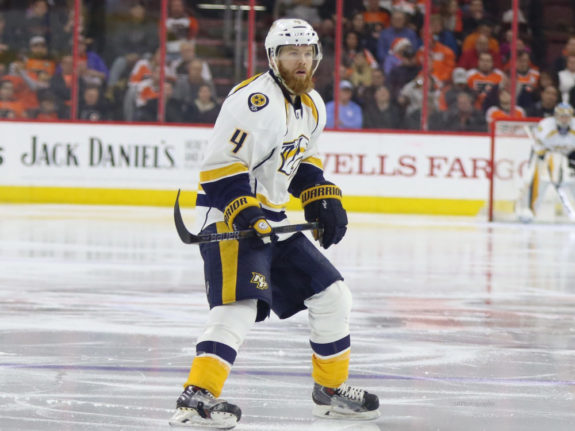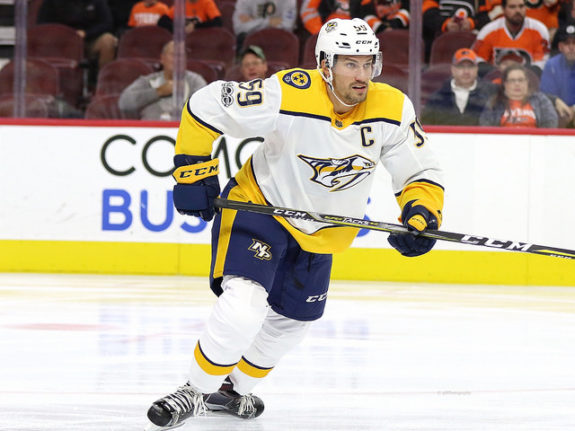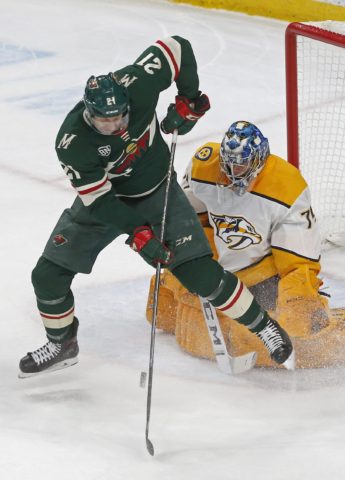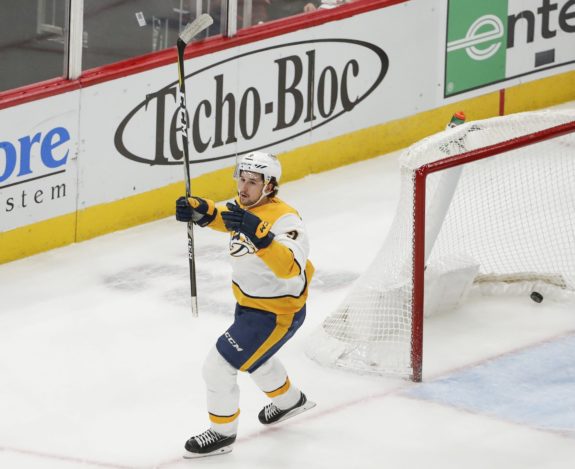The Nashville Predators kicked off the 2020-21 season with a pair of wins at home against the Columbus Blue Jackets and followed it up with a strong performance despite losing to the Carolina Hurricanes. With the Predators’ games temporarily on pause due to a potential outbreak of COVID-19 on the Hurricanes’ roster, it’s a good time to reflect on the success the Predators’ had in their first three games and what I took from the start of the season.
Keeping in mind head coach John Hynes has a brand new set of assistant coaches in Todd Richards and Dan Hinote, and the lack of pre-season games to work out any kinks, it’s natural to think the Predators could have experienced some adjusting time in certain areas of the game. Through three games, I’d say there is much more reason to be optimistic than pessimistic.
The Penalty Kill Looks Great
Last season, the Predators’ penalty kill was not very good. In fact, it was pretty bad, operating below the National Hockey League average and ranking 29th out of the 31 teams in that category. Through three games this season, they have only allowed one goal in eight power-play opportunities against. In the first two games against Columbus, the Predators were perfect on the penalty kill, an impressive feat considering the firepower of the Blue Jackets’ power play includes Zach Werenski, Seth Jones and Pierre-Luc Dubois.
Yes, I’m aware that some of the penalty kills against Carolina were abbreviated in nature due to overlapping penalties by the Predators, but the fact remains that the penalty kill looked really strong. Particularly against Columbus, the Predators suffocated opposing forwards, smothering them in the defensive zone and not allowing the power play unit to even set up and sustain any pressure.
The top penalty-killing duo up front of Brad Richardson and Calle Jarnkrok were lights out in their penalty killing duties, with Colton Sissons and Luke Kunin forming a good second unit. Ryan Ellis appears to be the go-to blueliner on the penalty kill and has performed his job admirably with almost two minutes of shorthanded ice time per game thus far.

Something worth noting on the Nashville penalty kill is the absence of Roman Josi, who averaged two minutes of shorthanded ice time per game last season. Through the first three games, he has a total of 58 seconds on the penalty kill. It would appear that Hynes is content to let his offensive dynamo focus on that part of his game, and allow players like Mark Borowiecki and Matt Benning to take on the secondary penalty-killing role on the blue line.
Once Luca Sbisa enters the roster, it will be interesting to see how he will factor into the penalty kill, considering near the top for the Winnipeg Jets when it came shorthanded ice time last season.
Borowiecki Is Going to Take Some Pressure Off Josi
Mark my words, BoroCop might end up being one of the most underrated off-season acquisitions around the entire league when it’s all said and done. Not only does he bring a physical presence and intensity to the Predators’ blue line, but his veteran composure and abilities could create room for Josi to excel even more than he did last season when he won the Norris Trophy.

As noted above, Borowiecki’s insertion into the penalty kill means Josi doesn’t have to be one of the first four defencemen skated out to kill penalties. I don’t think it’s a hot take to say that Josi’s strength is not in his own zone but moving the puck down the ice and in the offensive zone, so the less time he has to spend as a defensive presence, the better off the Predators can be.
If Sbisa and Borowiecki end up paired together once the former clears the league-mandated quarantine as a new acquisition, it will be interesting to see if this pair becomes the shutdown duo matched up against the opposing top line. If that is the case, it could free up even more room for Josi with more shifts against bottom-six forwards.
Borowiecki’s impact could also be felt in how fresh Josi is at the end of games and at the end of the season. So far in three games, Josi’s average ice time is down almost a full two minutes from last season, in part due to the more even platooning of all three defensive pairs by Hynes and his staff. Not only is Josi being counted on for fewer defensive zone situations, but he could also have fresher legs into the late stages of the season. In a 56-game schedule, that could be priceless in value into the playoffs, especially if injuries hit the Nashville defensive corps.
The Goaltending Is Going to Be Just Fine
Two of the biggest questions coming into the Predators’ season were in the crease, and how Juuse Saros would handle being the new number one, and how Pekka Rinne embraces the backup role? So far both questions have been answered fairly resoundingly to silence the critics and both in very positive ways for Nashville fans.

Saros looked almost unbeatable in the two games against Columbus, stopping 71 of 74 shots with a night’s rest in between games. The three pucks that got past him were from a breakaway goal, a weird deflection, and a rebound that stuck to the ice beside Saros after a Blue Jacket walked in untouched past a few Nashville defenders.
It’s tough for me to say objectively that any of these goals were Saros’s fault, but if any of them do fall into the “he should have had it” category, he definitely made up for it in many of the 42 saves he made in game number two. Most of those shots were high-quality scoring chances which Saros stood tall in net for, keeping the Predators in the game through 40 minutes before they unloaded four goals in the third period to pull away.
Monday night was Rinne’s chance to start against Carolina, and despite allowing three goals on 23 shots, most of the saves he made were once again quality opportunities. One save that stood out was as the second period was about to expire, Teuvo Teravainen bore down on Rinne, who made a vintage-Pekka save just before the horn sounded which allowed the Predators to remain tied up going into the third. He is no spring chicken at 38 years old, but his performance Monday leads me to believe he will provide valuable stability in a season filled with back-to-back game nights.
The Top-end Scorers Are Back
Much was said last season about the sudden disappearance of high-end scoring numbers from the top forwards on Nashville’s roster. So far, they have performed as expectations dictate, and not just from a numbers standpoint but a general offensive perspective.
The JOFA line of Ryan Johansen, Filip Forsberg and Viktor Arvidsson looked great in the offensive zone in all three games, leading to Forsberg scoring in each game. The offense the trio generated was more like the 2018-19 Predators, and less like the line from a season ago which struggled to maintain good offensive pressure for large portions of time.
With seven points combined through the three games, it’s not as though they are lighting up the scoreboard at will, but it’s worth noting that the opportunities have been there, and generally speaking the top line has been pretty solid. The JOFA line has been responsible for 24 of the team’s 101 shots on goal, a percentage that should surprise nobody. That percentage needs to stay around that figure for the benefit of the entire team and should result in all three players reaching high point totals by season’s end.

Matt Duchene has looked right at home centering the second line with Erik Haula and Kunin, although I would have to think Mikael Granlund could potentially replace Kunin on this line once he is able to return. However, Kunin’s two goals in the first two games might keep him on that line for the time being. In any case, Duchene has two assists to start the season and has shown flashes of the dynamic superstar who was a 30-goal scorer in Colorado in what feels like a lifetime ago.
It also appears as though Duchene could play a pivotal role on the power play’s first unit as the fourth forward, allowing either Forsberg or Arvidsson to drop back to the point with Josi. Duchene’s addition to that unit makes it one of the more intimidating and dynamic power plays on paper, and could take a couple of more games to warm up – remember, no pre-season games mean the Predators are still sorting some things out, and once this power play heats up it will be incredibly tough to defend against.
Only a week into the regular season, the Predators have to be pleased with how the season started and should be able to take many positives from each game, including their loss against the Hurricanes. With four of the next six scheduled games against the teams who faced off in the Stanley Cup Final in October, the Predators need to draw on this optimism from the first three games while improving every game in what should be a hotly-contested Central Division.
With some unexpected days off this week, it will be interesting to see if the Predators are able to stay the course, or if the time off forces them to deviate from the plans that worked well through the first three games of the season.